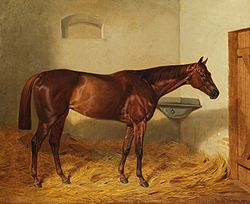| Kincsem | |
|---|---|
 Kincsem painted by Emil Adam in 1887, from a print. | |
| Sire | Cambuscan (GB) |
| Grandsire | Newminster |
| Dam | Water Nymph |
| Damsire | Cotswold (GB) |
| Sex | Filly |
| Foaled | March 17, 1874 |
| Died | March 16, 1887[1][2] |
| Country | Hungary (As Austria-Hungary) |
| Colour | Liver chestnut |
| Breeder | Ernő Blaskovich |
| Owner | Ernő Blaskovich |
| Trainer | Robert Hesp |
| Record | 54: 54–0–0 |
| Earnings | ƒ199,754.50 = €2.56 millions in 2020[3] |
| Major wins | |
| Hungarian Two Thousand Guineas (1877) Hungarian One Thousand Guineas (1877) Hungarian Autumn Oaks (1877, 1878, 1879) Hungarian St. Leger (1877) Austrian Derby (1877) Austrian Kaiserpreis (1877) Grosser Preis von Hanover (1877) Grosser Preis von Baden (1877, 1878, 1879) Staatspreis Erster Classe (1878) Goodwood Cup (1878) Grand Prix de Deauville (1878) | |
| Honours | |
| Kincsem Park in Budapest, Hungary Kincsem Museum, Budapest, Hungary Kincsem Horse Park, Tápiószentmárton, Hungary Kincsem Hotel, Kisbér, Hungary Kincsem Farm, Archer, Florida Life-sized statue at Kincsem Park, Budapest | |
Kincsem (Hungarian pronunciation: [ˈkint͡ʃɛm]; Hungarian for "My Precious" or "My Treasure"; March 17, 1874 – March 16, 1887) was a Hungarian Thoroughbred racehorse who has the longest undefeated record of any racehorse after winning all of her 54 races. The next closest in this regard is Black Caviar, who won all her 25 races. Foaled in Kisbér, Hungary in 1874, Kincsem is a national icon and widely considered one of the top racehorses of the 19th century.
Over four seasons, Kincsem won against both female and male company at various race tracks across Europe, including multiple Classic race victories in the Austro-Hungarian Empire. She also raced frequently in Germany, winning the Grosser Preis von Baden three times. In her four-year-old campaign, she traveled to England to win the Goodwood Cup, then won the Grand Prix de Deauville in France.
As a broodmare, Kincsem produced just five foals, one of which died young. Nevertheless, two of her foals became Classic winners and her daughters also proved to be outstanding producers. Her family has proved a lasting influence on the breed, with modern descendants including English Classic winners Polygamy and Camelot.
- ^ "Vadász- és Versenylap, March 17, 1887" (in Hungarian).
- ^ "Neue Illustrirte Zeitung No.26/1887" (in German).
- ^ "Oesterreichische Nationalbank: Historischer Währungsrechner" (in German).